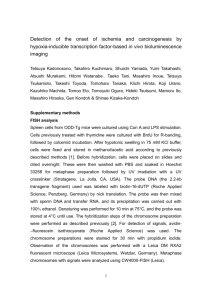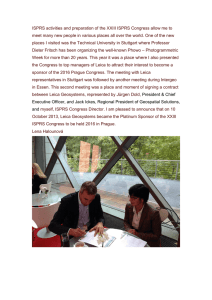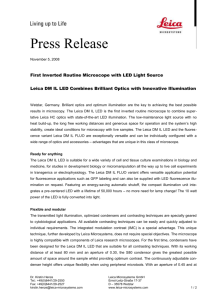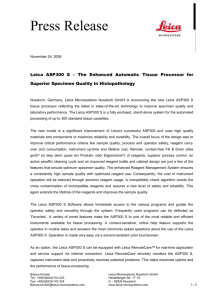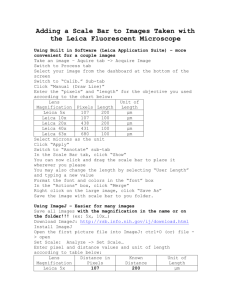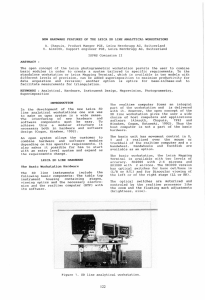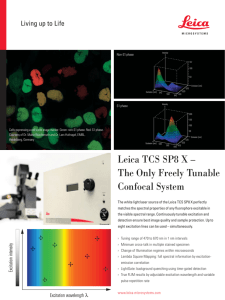Electronic Imaging Scott Kirkpatrick PostPC Computing course
advertisement
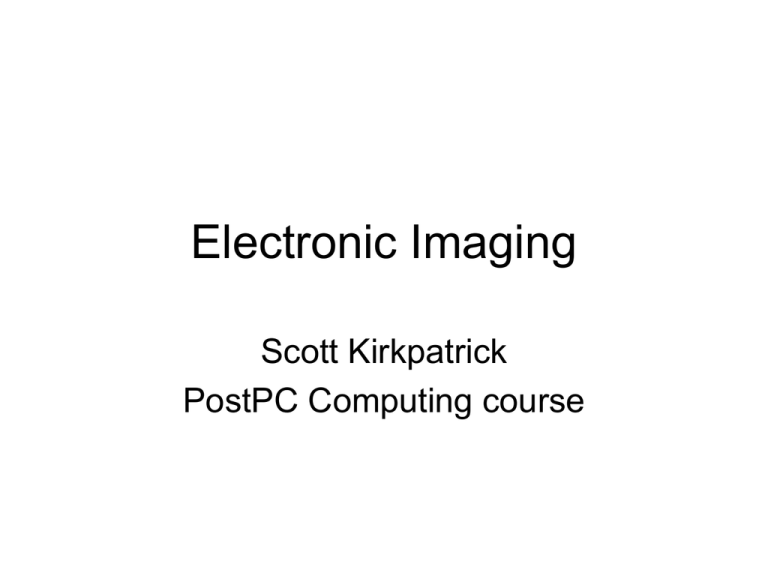
Electronic Imaging Scott Kirkpatrick PostPC Computing course Or, smags, firgels and queels From Robert Sheckley’s story “Milk Run” (1954 or so). Your job – pilot a space freighter with a cargo of smags, firgels and queels. Sound easy? Well, the queels shed steely wool which clogs the ventilators. They need high gravity to eat or they will starve. High gravity makes the smags shrink and die, but raising the humidity stabilizes them. Only now the humidity wakes the firgels from their convenient dormant state, and the result is anything but convenient… Does this sound at all like engineering a new product? Remember film? • It’s not dead, but has become specialized. • Electronic imaging is almost completely different! • Black and white – a negative process (long history) • Color – both negative and positive (transparency) processes survive • ISO standards characterizing sensitivity – Very fine grain – ISO 10-50 – General purpose – ISO 100-400 – Ultra fast – 800-3200 One film fits all? • ISO defined by exposure required to produce standard density: • ISO = const. x (fxf) / (t x Luminance)) – Implies t = const/ISO on a sunny day Replace film with Silicon • Photons in an image => electrons trapped in a “well” – When the well is full, it overflows (clips) • Analog circuitry moves them to an A/D stage where they are sensed and rendered digital. – CMOS, CCD approaches differ in details, costs, strengths – CCD uses “bucket brigade”, CMOS addresses each pixel • ISO becomes almost magically adjustable by scaling up weak output as needed, as long as noise floor permits: Quality aside, film and digital look different Robert Frank, Leica, ca. 1955 Tri-X, ISO 200? Leica M8 test shot, ISO 640, 2006 (R. P. Ottavi) Leica M8 case study Outline • Leica history – 80 year legacy of world’s finest lenses for small cameras – all mechanical, manual operation • Contents of a digital camera – Directions for ultimate quality in small digital cameras – Olympus 4/3; Leica • M8 decisions and timeline before shipping • Response to the shipped product • What will happen next? (subsequent to Jan 2007) Leica’s history and culture • • • • • 1849 firm founded, became Leitz in 1869 1913 first prototype camera (Oscar Barnack’s “Ur-leica”) 1924 first product 1930 interchangeable lenses 1932 rangefinder – Altogether 800,000 early Leicas sold. – (Freedom Train story shows Leitz an unusually ethical firm) • • • • • • 1953 M3 introduced, followed by M2, M4 1964 Leica slr (later with Minolta) 1996 With founding family gone, company goes public 1998 auto exposure (M7) 2004 A la Carte, Boutique products for collectors (Hermes) 2005 Under new owners, return to basic SLR, RF and minicamera products (with Panasonic and Olympus) Contents of a digital camera • Basic elements – – – – – – Imager (CCD or CMOS), A/D, timing circuits DSP, buffers, removable memory Image assessment and management (LCD) Viewfinder (reflex, optical, or video; RF?; LCD; none) Lens and shutter Case Strategies for ultimate small digital cameras • • Issues: resolution, dynamic range, DOF, noise Two strategies focus on vignetting at wide angles – – Olympus: “4/3” telecentric lenses with exit pupil >50 mm from imager Leica: modify chip and firmware to overcome vignetting • • Allow exit pupil as close as 25 mm from imager Second problem, less talked about: IR – – Issues are false colors, decreased sharpness, and a novel kind of vignetting. Bad experiences on this: • • Kodak mid ’90s Nikon D1, D1X, D1H, D100 (2000-2002) How do smags, firgels and queels apply? • On Leica’s ship, there are three decks. Smags sit close to the pilot. They know the legends, navigate, did the UI, invented the bar code. Now they are all out marketing. • Firgels write firmware, are mostly new hires, sit in the middle writing requirements for Further Firgels to execute. Their job is eliminating vignetting (whatever that turns out to be) to get the maximum digital performance for those wonderful lenses. When their hands are idle, they invent new features… • Queels are the “real” engineers, working with their Kodak brethren to achieve intergalactic dynamic range and maximum performance. They don’t solve every problem, but for that there is firmware… Compare specs KAF 10500 vs 10100 KAF 10500 (M8 chip) KAF 10100 (DMR chip) What’s vignetting all about? 21 mm f/2.8 28mm f/2.8 Problem – camera doesn’t know the lens aperture! 28 mm f/2.0 50 mm f/1.0 M8 development timeline • 2005 define (w. Kodak) new ultimate sensor to take advantage of Leica’s RF lenses (existing and future) – – – – Dual outputs replace single, 2x sensitivity, 1.5x DR Thinner coverglass, no AA filter (KAF 10100 also used no AA) Offset microlenses Weaken IR/photometric filtering for extra sharpness • 1H 2006 (w. Jenoptik) develop firmware – Complete elimination of vignetting for coded (Leica) lenses – 8 bit sqrt encoding of the raw data in DNG file • 2H 2006 (w. PhaseOne) develop post processing s/w – Color profile(s), DNG reader. – ACR, SilkyPix, others can also read the files. IR spectrum IR-response of KAF 10500 KAF 10500 IR filter KAF 10100 420 – 630 nm >80% 700 – 750 nm <5% 750 – 1000 nm < 1.5% Pre-release and shipment timeline • August, September 2006 – Cameras in the hands of professional photogs, reviewers, friends. Images embargoed. Reviews very positive, concerns focused on difficulty of access to digital image controls. – Distributed to celebrities in Sept 2006 • Last week, October 2006 production firmware released. Image embargo lifted, reimposed. – 8/16 bit encoding discovered, inconsistent with pubs. – Streaking, blobs observed in some images – 5 or 6 positive reviews with images appear • First week, November 2006, 1500 units shipped – Streaking proves more serious, IR problem recognized Example: streaking R P Ottavi Example: IR problems Jacket on left is black, tuxes have black lapels, not purple Wedding photographers have a problem, but so do street shooters (a key Leica fanbase). Natural images see lightened greens, loss of sharpness. IR problems contained with external filter Without IR-cut filter With IR-cut filter Guy Mancuso Now for the unexpected features… Leica’s new “bar code” for its lenses: www.popflash.com Becomes a Sharpie Code Mike Prevette, Nov 29, 2006 shows how to impersonate almost any Leica lens. Codes needed are tabulated on web. So that the observed vignetting f/8 B,G vignetting f/4.5 Red vignetting 1940’s Zeiss Biogon 21 Can be corrected by leica impersonation Leica recovery efforts • When did they know about the IR problems? – Phase One in October knew that additional filtration was the only option and their story was consistent then with Leica’s later announcements. • Management statements: – Relayed memo (technically garbled) ducked blame, said use filters (Nov. 8) – Official statement from Product Manager acknowledges problem, sets 2 week deadline for announcing response planned (Nov 10) – Shipments halted. • Deal (announced gradually over Dec. 2006) – Filters required, hardware “upgrade” (= recall) strongly recommended – Each buyer gets two free filters, early buyers get lens direct from Leica of choice at 30% off (off what?), CEO personally apologizes. Official statements • November 10, 2006 12:53 • • • • • • • • • Message to the customers of the LEICA M8 Dear Friends of Leica, Customer feedback to us following the start of shipment of the LEICA M8 points to a performance under certain conditions that does not meet the expectations in the Leica brand. Our technical and engineering teams have isolated the source of these concerns and have identified definitive solutions. Over the next two weeks we will communicate a plan to further assure you of your investment in the LEICA M8. We hope for your understanding and support. Please accept that I will not be able to answer all messages in the forum personally. • • Kind regards Leica Camera AG • • Stefan Daniel Product Management CEO’s apology Letter to all pre-Dec 31 purchasers, from SK Lee: “I am writing to you directly now because we have discovered, after shipment of the M8 began, that very occasionally, certain aspects of early shipment cameras were not up to normal Leica standards. These artefacts neither happen often nor to everyone, but they do happen, and we are responsible…. We sincerely apologize for this oversight. …We are confident that cameras shipped from our factory as of November 27, 2007 are tested thoroughly to be defect free. ...We understand that this situation is a tremendous nuisance to you, and would like to extend an unprecedented gesture to compensate you directly for the trouble we caused. Therefore… But technical problems are not over… The rainbow: Jaap V, 11 Nov, 2006 Problem is reproducible, occurs on startup from standby. Noise floor isn’t smooth or flat… Vertical structures in the background noise show up in low light images. Guy Mancuso, Michael Francis, Ray Harms Nov, Dec 2006 Peripheral reference pixels can be fooled… 1 2 3 4 Furrukh Khan, 29 Dec 2006 Answer may involve use of automatic dark frame subtraction. Another reference value problem? Phil Evans, 22 Dec 2006 This kind of imbalance is also seen in high end digital camera backs, where sensors are segmented in a mosaic. Role of online forums in beta test • Most problems identified quickly, and consensus developed on their seriousness – 8/16 bit controversy surfaced with first leaked DNG files • A PR embarassment, not a technical problem – IR false color seen and shared in first 3 days – Horizontal bleeding characterized in first week, along with certain mirrored artifacts – Rainbow seen early, not addressed until after recall – False peripheral black pt streaking detected in 1-2 wks after shipment of first fixed units after recall. – Occasional dead units continue to occur, most possibly involving battery subsystem. – Possibility of hand coding stimulates study of vignetting corrections that Leica firmware applies. Conclusions • Extensive beta testing aimed at finding problems, not just stimulating customer interest, is just as important in consumer hardware as in software. • Evident culture gap at Leica. • Management does not seem very technical, thus caught by surprise. Somebody dropped the ball in early 2006 on managing IR response. • Sensor fix is best, but is it affordable? (Ans. NO) • Engineering response time improving and readiness to deal with Internetdiscovered problems has been very positive. • Camera, despite all this flap, takes great pictures and is very satisfying to use. With the newest lenses (28mm f/2.0 ASPH) Indoors or out: 50yr old lenses (Canon 19mm f/3.5): Also an old lens (Canon 35mm f/2.0):
